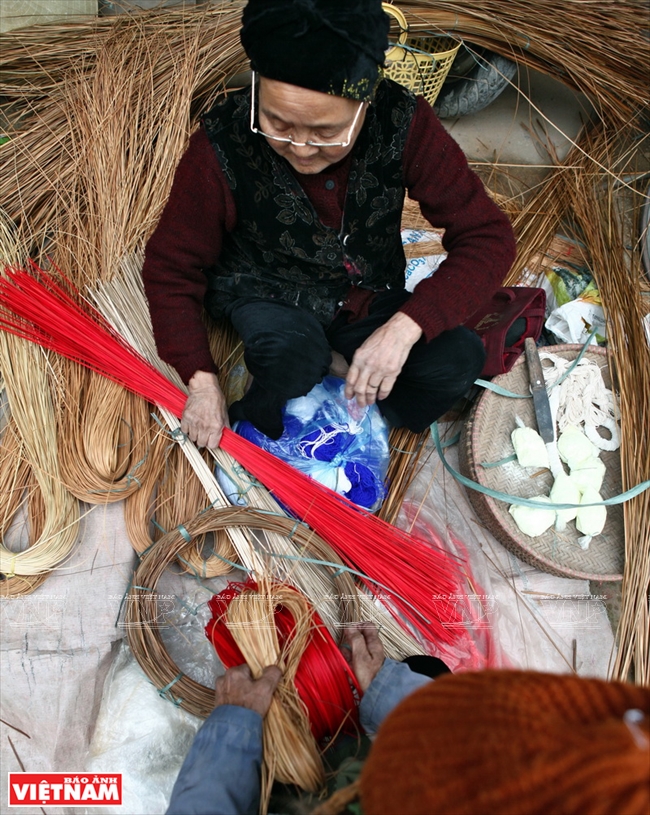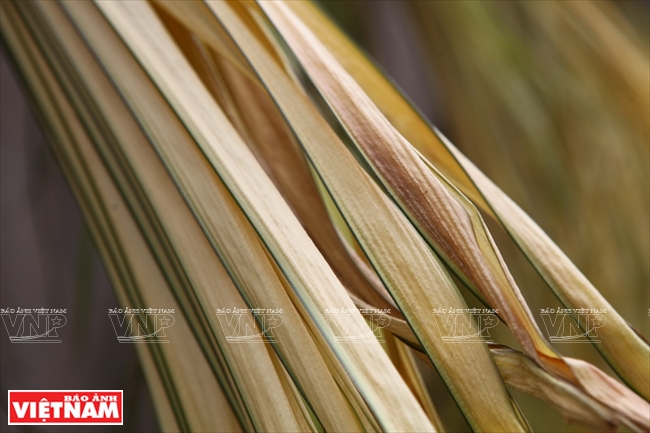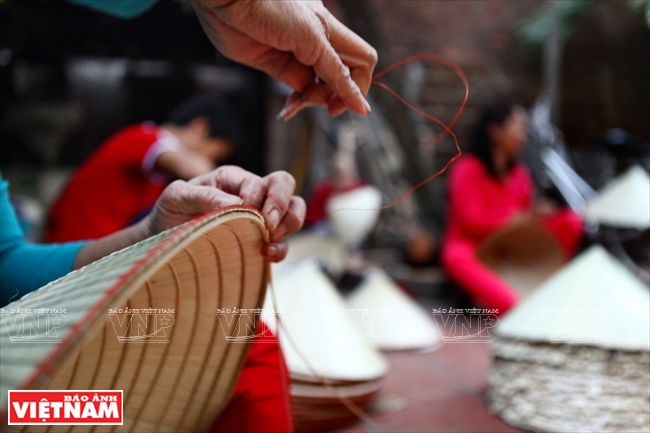Following the guidance of local residents in Ngoc My commune, we arrived at the house of Do Thi Chi's family, one of the households with a long history of making non la. Chi, who is 70 years old, was taught how to make Non la by her parents at the age of 10. She does not know when non la making started in Ngoc My commune but most of the local children learn from their parents the way to layer and sew palm leaves to make non la. Regular practice over time sharpens their skills and perfects their products. In order to make non la, Ngoc My residents buy palm leaves from Phu Tho and Thai Nguyen provinces. The leaves are sundried 2-3 days to wither before being heated over fire and ironed out by a stuffed fabric ball. Flattened leaves are afterwards cut so that they have pointed ends.
Non la frames are bought from Chuong Village in Thanh Oai, Hanoi. Thin bamboo splints are bent into circular rims surrounding the frame. After that, leaves are placed on the frame before sewing. Sewing is the most demanding stage as leaves can be easily torn, which requires delicacy at every stage. What strikes visitors to Ngoc My is that even small children can manage to sew non la at a high speed while still producing even stitches surrounding the frames. After finishing the sewing, the leaves are cut out and the largest, outermost rim is hemmed.
According to Vuong Thi Xuan, who has more than 20 years of experience making Non la, the craft is a side occupation that Ngoc My residents take up in addition to farming. Therefore, in each household there are only one or two people involved in it. Children often help their parents after school. This is the reason why most experienced non la makers were taught by their parents during childhood. It also motivates them to pass on the traditional craft to their offspring.

Material to make rims and chin straps are sold in Chuong market.

To make Non la, Ngoc My residents buy young palm leaves from Phu Tho
and Thai Nguyen provinces and sundry them in 2-3 days.
 Bamboo is used to make the rims of Non la. Bamboo is used to make the rims of Non la.

Perfecting bamboo splints to make rims.

Non la frames are ordered from Chuong village in Thanh Oai, Hanoi.

The first stage is to bend bamboo splints into rims.

Sewing is the most difficult stage as leaves are easily torn and requires carefulness.

After the sewing is finished, the remaining leaves are cut out.

A Non la making household in Ngoc My.

A skillful Non la maker can finish 2-3 complete products a day.

With its high quality and modernised models, Ngoc My Non la has been widely traded, especially in Chuong market. |
Over the course of time, Ngoc My's Non la has been modernised but still preserves its charming and elegant characteristics. To decorate Non la, sometimes makers use colourful threads to sew or attach colourful chin straps which help position the non la while worn.
According to Nguyen Manh Han, whose family is a Non la making household in Ngoc My and who is now involved in buying local made Non la and trading it, the price of Non la varies from 16,000 to 60,000VND each. There are two main types of Non la produced here. One of high quality is often consumed domestically while the other of less quality is exported to China. The latter has thinner leaves layered with stitches further apart. The former has thicker leaf layers and more delicate and closed stitches. On average, a skillful Non la craftsperson can make 2-3 complete Non la a day. Annually each year an average household can make 180-200 million dong from making Non la.